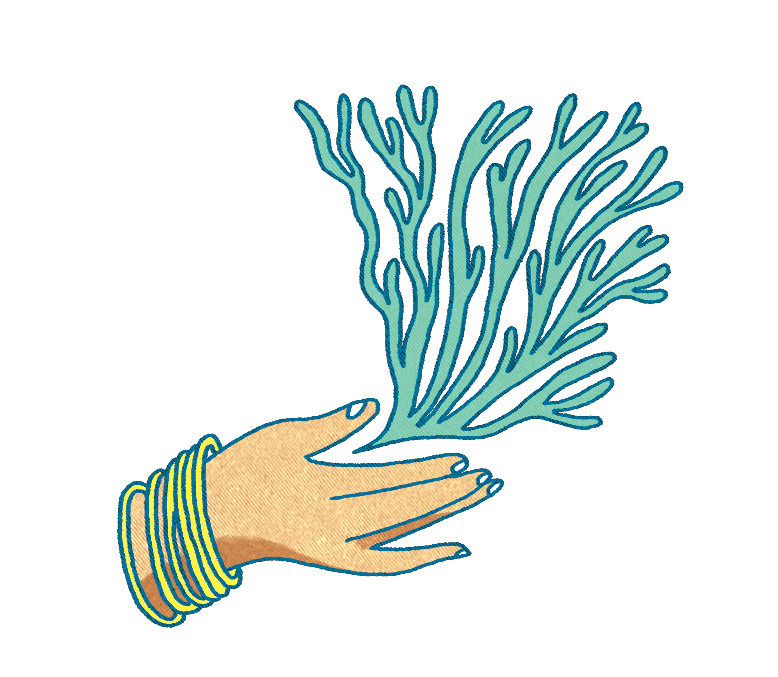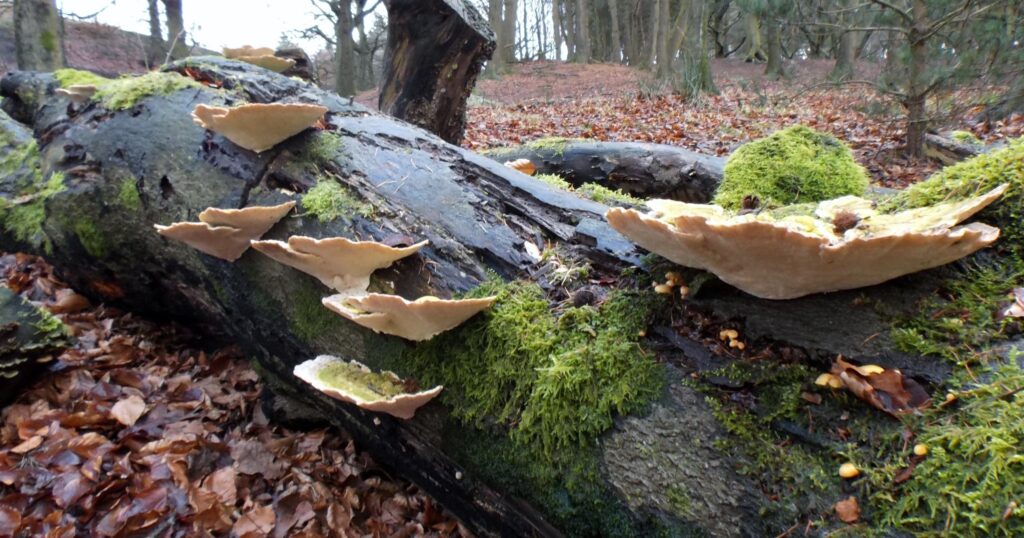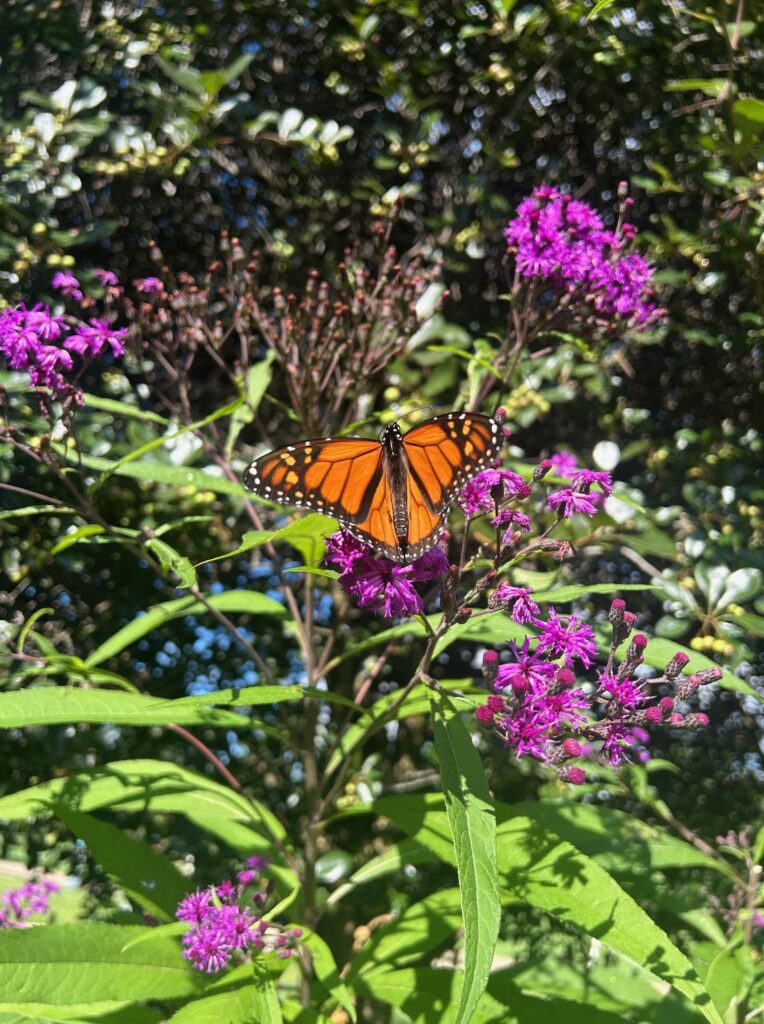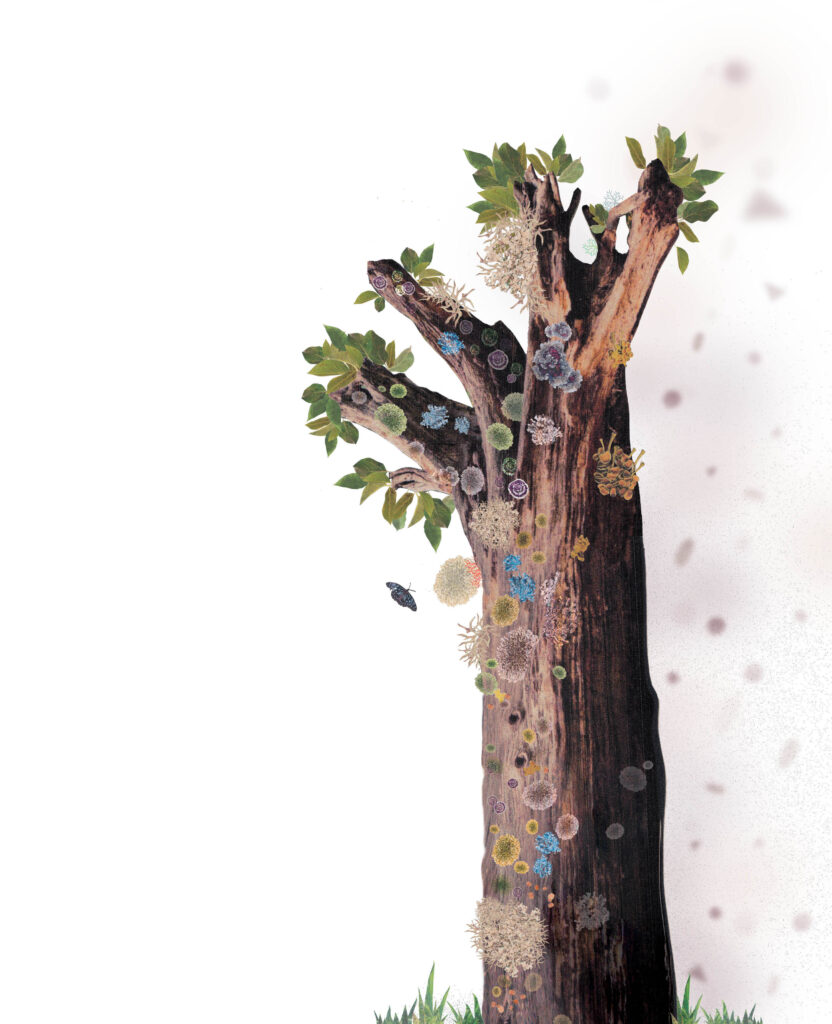Commercial seaweed farming is the new oceanic frontier in the blue economy era. Marine plants like seaweed have great potential in combating global warming and climate change by sequestering carbon and restoring ecosystems. Seaweed absorbs carbon dioxide through photosynthesis, and its cultivation can sequester up to 1,500 tons of carbon dioxide per km2 annually.
Seaweed also contributes to long-term blue carbon storage when decomposed or buried in sediments. While an increase in atmospheric carbon dioxide could lead to ocean acidification, seaweeds can mitigate its impact by using carbon dioxide for growth, helping to stabilize pH levels. Furthermore, seaweed farms create habitats for marine life, enhance biodiversity, and help mitigate coastal erosion, thereby strengthening resilience against climate change.
Underwater farms
Estimates from the Food and Agriculture Organisation of the United Nations show that approximately 35.8 million tonnes of world algae production (including seaweeds and microalgae) was contributed by 54 countries/territories, with 97 percent of the output coming from cultivation. While China, Indonesia, Korea, Japan, and the Philippines have emerged as lead players in commercial seaweed cultivation in Asia, African countries along the western Indian Ocean, such as Tanzania, Kenya, Madagascar, Mozambique, and Mauritius, are also known for seaweed production.
In India, Gujarat and Tamil Nadu coasts are known for their seaweed diversity and abundance. Abundant seaweed beds are also found along the coasts of Mumbai, Ratnagiri, Goa, Karwar, Varkala, Vizhinjam, Pulicat, and Chilika. Studies show that there is high scope for scaling up commercial seaweed farming on the coasts of Karnataka, Maharashtra, Goa, Kerala, Lakshadweep, Andhra Pradesh, Odisha, and West Bengal.
The Tamil Nadu coast—particularly the Gulf of Mannar and Palk Bay—is a rich biodiversity hotspot for seaweed. In the context of declining fish production and uncertainties in fisheries-based livelihoods, commercial seaweed farming is an alternative livelihood source for many small-scale fishing families along Tuticorin and other parts of the Coromandel Coast, and more specifically along the Gulf of Mannar Biosphere Reserve on the southern coast of India.
Documents published by the Central Salt and Marine Chemicals Research Institute (CSMCRI) and oral histories with local communities show that PepsiCo entered into a formal agreement with CSMCRI for developing seaweed farming technology in 2000. The pilot project commenced in February 2001, when the state government granted PepsiCo access to 1 km of waterfront for seaweed cultivation in Munaikkadu, in the Ramnad district of Tamil Nadu.
By 2003, the project expanded its scope through the test trial of 100 floating bamboo rafts for cultivating elkhorn sea moss (Kappaphycus alvarezii)1. At the same time, the project began to endorse contract farming involving local community members and self-help groups. After the tsunami in 2004, seaweed farming was envisaged as a key strategy to rehabilitate tsunami-affected fishers in the southern districts of Tamil Nadu.
Today, firms like AquAgri, Sea6 Energy, and Pssgt Nextgen Export Company are the key competitors in the seaweed value chain. Some of these firms also engaged in socially innovative processes such as registering fishers, providing them seedlings on credit, and deducting costs from earnings. In collaboration with institutions such as CSMCRI, these firms offer training and capacity-building programmes to seaweed farmers to boost production and deal with emergent crisis situations such as extreme weather events or pest attacks. Through the analysis of narratives and life stories of selected fishers-turned-seaweed farmers located in the outskirts of Tuticorin city, we can understand the impacts of the new materials and ideas around seaweed in shaping their everyday lives. We interviewed 15 fishers-turned-seaweed farmers and observed their daily livelihood practices closely.

Fishers to farmers
Born into families of fishers, the people we spoke to relate to the ocean based on the knowledge shared by their elders and others who are intimately familiar with the ocean. The nature-culture entanglements reflected in terms of their knowledge, relationships, and livelihood practices with the ocean inspire these people to hope for, take risks, and engage persistently with an entrepreneurial spirit. For Murugan, a middle-aged fisher-turned-farmer, the ocean is an encyclopedia that we need to closely observe and peruse to enable sustainable living. “If the wind blows in the right direction, the rains arrive on time, and if the waves remain calm, then we can succeed in seaweed farming.”
For Ajitha, a 32-year-old woman, seaweed farming as a livelihood opportunity emerged when her father shifted from fishing to seaweed farming. In her view, it is the tides that ensure the sustenance of all beings—for aquatic organisms in the sea and people on land. She observes that it is a pure business enterprise for private firms. Nevertheless, for her, it is a means of survival and another way of forging connections with the ocean and her late father. She continues, “The sea has provided for my family, and I have devoted my life for them (sea, seaweed, and family).” For some people, “the sea is their lifeline, companion, and teacher”; for others, the sea is more than a livelihood asset, “a spiritual connection linked to our existence”.
The last two decades have been difficult for these fishers, as there has been a considerable decline in fish catch due to factors such as overexploitation, ocean warming, and extreme weather events. Recalling days of both plentiful catch and empty nets, they say, “Fishing these days has become like gambling. As fish stocks declined, some of us ventured into selling fish in the retail market, but we failed, and losses mounted. A few others shifted to clam collection. During that time, CSMCRI introduced us to seaweed farming, which in a sense became our last hope.”
Gradually, they set up their seaweed farm using inputs such as seeds, ropes, and plastic bottles. Also, they were excited to learn new things about the seaweed. As fisher-turned-farmer Thangapandi remarks, “I have been fortunate to observe how different species grow in various locations. It is fascinating to learn how nature operates.” Nonetheless, they had to endure the harsh sun, confront the unpredictable sea, and adapt to newer farming techniques.
In their own words, “Seaweed farming requires patience and precision. We tie fresh seeds to ropes with plastic bottles and lay them in the water. After 25-30 days, we harvest. It sounds simple, but nature decides everything,” referring to the rough seas, unpredictable rains, and fluctuating temperatures. Due to strong winds and fungal infestations in the raft (a shell type fungi, which fishers locally call as kotrasi), they had to shift from bamboo rafts to the monoline method. They also tried the tube method without much success. Thangapandi says, “It is not just about planting and harvesting. You must continuously monitor tides, check for pests, and always be alert for sudden weather changes.”
For women like Selvi, work starts before sunrise, managing their household and workers. Selvi is a homemaker and businesswoman, managing finances and ensuring fair prices for the fish catch her husband brings to the harbour. Though her husband is an experienced fisher, he struggles with numbers. “My husband goes fishing but does not know math or accounting,” she says. “So, I handle the auction at the harbour.” She ties seaweed, prepares meals, and oversees farming during the seaweed planting season. “If there is no work on our plot, I go elsewhere,” she said. According to her, seaweed farming has provided some financial security. “The money we get is higher than from fishing,” she noted.
Combined earnings range between INR 20,000–25,000 (USD 236–295) a month. Entrepreneurs like Murugan have invested in a machine to process seaweed into liquid fertiliser, expanding their market reach to Gujarat. “With the machine, I now earn about INR 80,000 (USD 945) a month. I never imagined this when I struggled with fishing,” he proudly added. However, Murugan is among the few successful seaweed farmers in the community, while many others are still struggling to establish a secure livelihood base.
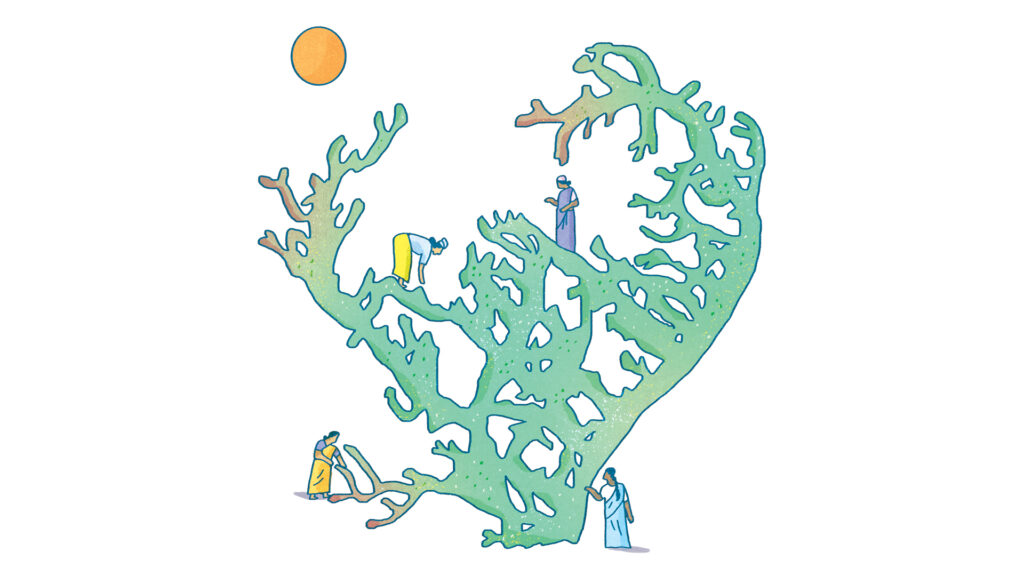
Not all rosy
Ocean warming and climate change fuel uncertainties such as the quick spoilage of seaweed. Fishers also note, “The heat in this area has always been high, but it has increased recently. Some fish species are also no longer found here.” Unlike earlier days, weather prediction remains difficult despite technological advances. Further, the fishers observe that the trends to intensify seaweed production throughout the year depletes the reefs by depriving them of their nutrient supply.
Some fishers remark that seaweed farming can only be a supplementary income and cannot replace fisheries as a primary source of livelihood. Earlier, while they were into full-time fishing, community solidarity enabled fishers on this coast to navigate crises together. However, with the diversification into seaweed farming, a sense of individualism predominantly manifests through competition and jealousy among people. Despite mutual dependence, rivalries sometimes lead to acts of sabotage, such as cutting ropes of competitors’ seaweed lines to disrupt harvests.
There are also several barriers, such as market access, pricing, and poor subsidies. Our research participants share that everyday interactions with government and private stakeholders are often complex for a community with a sense of autonomy and occupational freedom. Though private companies provide essential buy-back systems and farm inputs, these are often met with strict sanctions and expectations. Private firms control pricing and market access, constraining their opportunities to sell seaweed independently.
“It is frustrating because we do all the work but have the least control over pricing. They give us just enough to survive but not enough to thrive,” a seaweed farmer said. Buyers prefer to deal with private firms for bulk or wholesale purchases. When asked about loans and subsidies from the government, he responded bitterly, “Even fishermen struggle to get financial help. Who will think about seaweed farmers?”
To summarise, though seaweed farming has emerged as an alternative livelihood source for fishers, climate uncertainties, market barriers, and shifting community relations add new dimensions to their everyday livelihood struggles. Amidst all these challenges, they are still hopeful that the ocean will support them and take care of their needs, as she used to do before the seaweed’s arrival.
Further Reading
CSIR-CSMCRI. 2019. Scope of seaweed farming in India. Bhavnagar: CSIR-Central Salt and Marine Chemicals Research Institute. http://dx.doi.org/10.13140/RG.2.2.10001.07520.
Doumeizel, V. 2023. The seaweed revolution: How seaweed has shaped our past and can save our future. London: Hero.
Froehlich, H. E., J. C. Afflerbach, M. Frazier and B. S. Halpern. 2019. Blue growth potential to mitigate climate change through seaweed offsetting. Current Biology 29(18): 3087–3093.e3. https://doi.org/10.1016/j.cub.2019.07.041.
- Kappaphycus alvarezii is a tropical red alga native to the Indo-Pacific region. Much has been written about the invasive characteristics of this species, which is known for its rapid growth, high adaptability, and ability to outcompete native organisms. While K. alvarezii is the commercial variety of seaweed cultivated in the farms, native varieties of Gracilaria edulis and Sargassum species are also collected from the ocean. ↩︎
